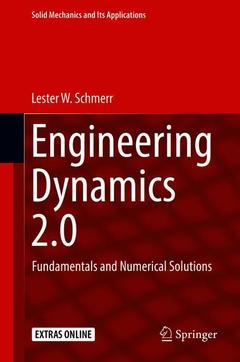Engineering Dynamics 2.0, 1st ed. 2019 Fundamentals and Numerical Solutions Solid Mechanics and Its Applications Series, Vol. 254
Langue : Anglais
Auteur : Schmerr Lester W.

This book presents a new approach to learning the dynamics of particles and rigid bodies at an intermediate to advanced level. There are three distinguishing features of this approach. First, the primary emphasis is to obtain the equations of motion of dynamical systems and to solve them numerically. As a consequence, most of the analytical exercises and homework found in traditional dynamics texts written at this level are replaced by MATLAB®-based simulations. Second, extensive use is made of matrices. Matrices are essential to define the important role that constraints have on the behavior of dynamical systems. Matrices are also key elements in many of the software tools that engineers use to solve more complex and practical dynamics problems, such as in the multi-body codes used for analyzing mechanical, aerospace, and biomechanics systems. The third and feature is the use of a combination of Newton-Euler and Lagrangian (analytical mechanics) treatments for solving dynamics problems. Rather than discussing these two treatments separately, Engineering Dynamics 2.0 uses a geometrical approach that ties these two treatments together, leading to a more transparent description of difficult concepts such as "virtual" displacements.
Some important highlights of the book include:
- Extensive discussion of the role of constraints in formulating and solving dynamics problems.
- Implementation of a highly unified approach to dynamics in a simple context suitable for a second-level course.
- Descriptions of non-linear phenomena such as parametric resonances and chaotic behavior.
- A treatment of both dynamic and static stability.
- Overviews of the numerical methods (ordinary differential equation solvers, Newton-Raphson method) needed to solve dynamics problems.
- An introduction to the dynamics of deformable bodies and the use of finite difference and finite elementmethods.
Engineering Dynamics 2.0 provides a unique, modern treatment of dynamics problems that is directly useful in advanced engineering applications. It is a valuable resource for undergraduate and graduate students and for practicing engineers.
Basic Elements of Dynamics.- Dynamics of a Particle.- Dynamics of a System of Particles.- Kinematics and Relative Motion.- Planar Dynamics of Rigid Bodies.- Dynamic and Static Stability.- Vibrations of Dynamical Systems.- General Spatial Dynamics of Rigid Bodies.- Dynamics of Deformable Bodies.- Appendices.
Les Schmerr received a B.S. degree in Aeronautics and Astronautics from the Massachusetts Institute of Technology in 1965 and a Ph.D. in Mechanics from the Illinois Institute of Technology in 1970. Since 1969 he has been at Iowa State University where he is currently Professor of Aerospace Engineering and Associate Director of the Center for Nondestructive Evaluation. He is also the Permanent Secretary of the World Federation of NDE Centers. His research interests include ultrasonics, elastic wave propagation and scattering, and artificial intelligence. He has developed and taught Ultrasonics and Nondestructive Evaluation courses at both the undergraduate and graduate level. He is the author of several books, including Ultrasonic Nondestructive Evaluation Systems (2007), Fundamentals of Ultrasonic Phased Arrays (2015), and most recently, the second edition of Fundamentals of Ultrasonic Nondestructive Evaluation (2016). He is a member of IEEE, ASME, ASNT and AIAA.
Includes many Matlab numerical simulations and animations that bring the behavior of dynamic systems "alive" for the reader Presents a unified matrix-based approach to dynamics suitable for a second-level course that provides a foundation for higher level studies and the use of dynamics in engineering practice Dedicated chapters on stability and vibrations explain the behavior seen in common dynamical systems Emphasizes the role of constraints in solving dynamics problems--providing a better understanding of the connection between Newton-Euler methods and Analytical Dynamics Introduces readers to finite differences and finite elements of deformable bodies, to be used as a basis for exploring and using these methods in advanced applications
Date de parution : 01-2019
Ouvrage de 707 p.
15.5x23.5 cm
Thèmes d’Engineering Dynamics 2.0 :
© 2024 LAVOISIER S.A.S.
